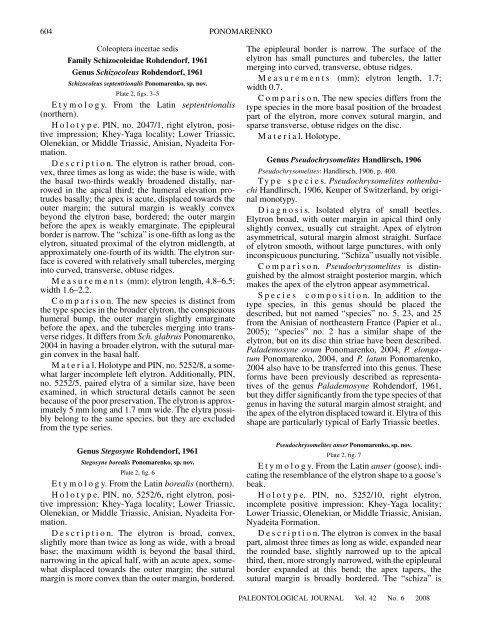New Triassic Beetles (Coleoptera) from Northern European Russia
New Triassic Beetles (Coleoptera) from Northern European Russia
New Triassic Beetles (Coleoptera) from Northern European Russia
You also want an ePaper? Increase the reach of your titles
YUMPU automatically turns print PDFs into web optimized ePapers that Google loves.
604<br />
<strong>Coleoptera</strong> incertae sedis<br />
Family Schizocoleidae Rohdendorf, 1961<br />
Genus Schizocoleus Rohdendorf, 1961<br />
Schizocoleus septentrionalis Ponomarenko, sp. nov.<br />
Plate 2, figs. 3–5<br />
Etymology. From the Latin septentrionalis<br />
(northern).<br />
Holotype. PIN, no. 2047/1, right elytron, positive<br />
impression; Khey-Yaga locality; Lower <strong>Triassic</strong>,<br />
Olenekian, or Middle <strong>Triassic</strong>, Anisian, Nyadeita Formation.<br />
Description. The elytron is rather broad, convex,<br />
three times as long as wide; the base is wide, with<br />
the basal two-thirds weakly broadened distally, narrowed<br />
in the apical third; the humeral elevation protrudes<br />
basally; the apex is acute, displaced towards the<br />
outer margin; the sutural margin is weakly convex<br />
beyond the elytron base, bordered; the outer margin<br />
before the apex is weakly emarginate. The epipleural<br />
border is narrow. The “schiza” is one-fifth as long as the<br />
elytron, situated proximal of the elytron midlength, at<br />
approximately one-fourth of its width. The elytron surface<br />
is covered with relatively small tubercles, merging<br />
into curved, transverse, obtuse ridges.<br />
Measurements (mm): elytron length, 4.8–6.5;<br />
width 1.6–2.2.<br />
Comparison. The new species is distinct <strong>from</strong><br />
the type species in the broader elytron, the conspicuous<br />
humeral bump, the outer margin slightly emarginate<br />
before the apex, and the tubercles merging into transverse<br />
ridges. It differs <strong>from</strong> Sch. glabrus Ponomarenko,<br />
2004 in having a broader elytron, with the sutural margin<br />
convex in the basal half.<br />
Material. Holotype and PIN, no. 5252/8, a somewhat<br />
larger incomplete left elytron. Additionally, PIN,<br />
no. 5252/5, paired elytra of a similar size, have been<br />
examined, in which structural details cannot be seen<br />
because of the poor preservation. The elytron is approximately<br />
5 mm long and 1.7 mm wide. The elytra possibly<br />
belong to the same species, but they are excluded<br />
<strong>from</strong> the type series.<br />
Genus Stegosyne Rohdendorf, 1961<br />
Stegosyne borealis Ponomarenko, sp. nov.<br />
Plate 2, fig. 6<br />
Etymology. From the Latin borealis (northern).<br />
Holotype. PIN, no. 5252/6, right elytron, positive<br />
impression; Khey-Yaga locality; Lower <strong>Triassic</strong>,<br />
Olenekian, or Middle <strong>Triassic</strong>, Anisian, Nyadeita Formation.<br />
Description. The elytron is broad, convex,<br />
slightly more than twice as long as wide, with a broad<br />
base; the maximum width is beyond the basal third,<br />
narrowing in the apical half, with an acute apex, somewhat<br />
displaced towards the outer margin; the sutural<br />
margin is more convex than the outer margin, bordered.<br />
PONOMARENKO<br />
The epipleural border is narrow. The surface of the<br />
elytron has small punctures and tubercles, the latter<br />
merging into curved, transverse, obtuse ridges.<br />
Measurements (mm): elytron length, 1.7;<br />
width 0.7.<br />
Comparison. The new species differs <strong>from</strong> the<br />
type species in the more basal position of the broadest<br />
part of the elytron, more convex sutural margin, and<br />
sparse transverse, obtuse ridges on the disc.<br />
Material. Holotype.<br />
Genus Pseudochrysomelites Handlirsch, 1906<br />
Pseudochrysomelites:<br />
Handlirsch, 1906, p. 400.<br />
Type species. Pseudochrysomelites rothenbachi<br />
Handlirsch, 1906, Keuper of Switzerland, by original<br />
monotypy.<br />
Diagnosis. Isolated elytra of small beetles.<br />
Elytron broad, with outer margin in apical third only<br />
slightly convex, usually cut straight. Apex of elytron<br />
asymmetrical, sutural margin almost straight. Surface<br />
of elytron smooth, without large punctures, with only<br />
inconspicuous puncturing. “Schiza” usually not visible.<br />
Comparison. Pseudochrysomelites is distinguished<br />
by the almost straight posterior margin, which<br />
makes the apex of the elytron appear asymmetrical.<br />
Species composition. In addition to the<br />
type species, in this genus should be placed the<br />
described, but not named “species” no. 5, 23, and 25<br />
<strong>from</strong> the Anisian of northeastern France (Papier et al.,<br />
2005); “species” no. 2 has a similar shape of the<br />
elytron, but on its disc thin striae have been described.<br />
Palademosyne ovum Ponomarenko, 2004, P. elongatum<br />
Ponomarenko, 2004, and P. latum Ponomarenko,<br />
2004 also have to be transferred into this genus. These<br />
forms have been previously described as representatives<br />
of the genus Palademosyne Rohdendorf, 1961,<br />
but they differ significantly <strong>from</strong> the type species of that<br />
genus in having the sutural margin almost straight, and<br />
the apex of the elytron displaced toward it. Elytra of this<br />
shape are particularly typical of Early <strong>Triassic</strong> beetles.<br />
Pseudochrysomelites anser Ponomarenko, sp. nov.<br />
PALEONTOLOGICAL JOURNAL<br />
Plate 2, fig. 7<br />
Etymology. From the Latin anser (goose), indicating<br />
the resemblance of the elytron shape to a goose’s<br />
beak.<br />
Holotype. PIN, no. 5252/10, right elytron,<br />
incomplete positive impression; Khey-Yaga locality;<br />
Lower <strong>Triassic</strong>, Olenekian, or Middle <strong>Triassic</strong>, Anisian,<br />
Nyadeita Formation.<br />
Description. The elytron is convex in the basal<br />
part, almost three times as long as wide, expanded near<br />
the rounded base, slightly narrowed up to the apical<br />
third, then, more strongly narrowed, with the epipleural<br />
border expanded at this bend; the apex tapers, the<br />
sutural margin is broadly bordered. The “schiza” is<br />
Vol. 42<br />
No. 6<br />
2008







